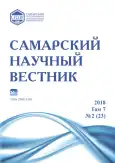Ecological and floristic features of the Samara Region nature monument «Kopeyka Mountain»
- Authors: Kalashnikova O.V.1, Murzyvanova S.V.1, Plaksina T.I.1
-
Affiliations:
- Samara National Research University
- Issue: Vol 7, No 2 (2018)
- Pages: 60-63
- Section: 03.02.00 – General Biology
- URL: https://journals.rcsi.science/2309-4370/article/view/21720
- DOI: https://doi.org/10.17816/snv201872111
- ID: 21720
Cite item
Full Text
Abstract
The paper presents the results of a comprehensive analysis of the nature monument «Kopeyka Mountain» flora nine years after the last descriptions of this area. To identify the ecology-floristic features of the mountain, a complete ecology-floristic characteristic was given according to the classical pattern. The taxonomic analysis has showed that on the stony steppe there are 150 species of higher plants, including 106 genera and 39 families. The leading families in the number of species are Asteraceae (28 species), Fabaceae (21) and Poaceae (11). A large number of species of the Fabaceae is one of the distinguishing features of Kopeyka Mountain. The predominant biomorph under the classification of I.G. Serebryakov is a group of herbaceous perennials, namely rod-root (39 species) and short-stemmed plants (25 species). The predominance of these life forms illustrates a high adaptability of plants to the conditions of their growth. The predominant hygromorph of xerophytic plants (67 species), revealed during the ecological analysis by N.M. Matveyev, also shows high suitability of the local flora to a lack of moisture in the mountainous terrain. Ecology-geographical analysis showed that the mountain-steppe group of plants was the largest in the number of species. A chorological analysis was also conducted, which showed the presence of all seven types of areals, of which Eurasian type (73 species) and European (34) were the leading ones. Endemic (45 species) and relic (15) taxa have been noted, which raises this monument of nature to a considerable height. In the flora of Kopeyka Mountain, 8 species are represented in the Red Data Book of the Russian Federation and 43 species are in the Red Data Book of the Samara Region. A decrease in the number of species in the flora of Kopeyka Mountain is a concern. It is necessary to introduce monitoring to protect the nature monument «Kopeyka Mountain».
Full Text
##article.viewOnOriginalSite##About the authors
Olga Vladimirovna Kalashnikova
Samara National Research University
Email: kalashnikova.samara@mail.ru
candidate of biological sciences, training master of Ecology, Botany and Nature Protection Department
Russian Federation, SamaraSvetlana Vadimovna Murzyvanova
Samara National Research University
Email: mur-svetavip@mail.ru
student of Biology Department
Russian Federation, SamaraTamara Ivanovna Plaksina
Samara National Research University
Author for correspondence.
Email: plaksinati@mail.ru
doctor of biological sciences, professor of Ecology, Botany and Nature Protection Department
Russian Federation, SamaraReferences
- Реестр особо охраняемых природных территорий регионального значения Самарской области / сост. А.С. Паженков. Самара: Экотон, 2010. 260 с.
- Кудашкина Т.А., Плаксина Т.И. Раритетные виды растений памятника природы «Гора Копейка» // Самарская Лука: проблемы региональной и глобальной экологии. 2009. Т. 18, № 4. С. 148-151.
- Сводный список особо охраняемых природных территорий Российской Федерации (справочник). Ч. II / Н.А. Потапова, Р.И. Назырова, Н.М. Забелина и др. М.: ВНИИ природы, 2006. 364 с.
- Плаксина Т.И., Головин В.И. Гора Копейка // «Зеленая книга» Поволжья: Охраняемые природные территории Самарской области / сост. А.С. Захаров, М.С. Горелов. Самара: Кн. изд-во, 1995. С. 297-298.
- Ильина Н.С., Ильина В.Н., Родионова Г.Н., Цветкова В.А. Характеристика комплексного памятника природы «Гора Копейка» // Исследования в области естественных наук и образования. Самара: Изд-во СГПУ, 2005. С. 156-165.
- Ильина В.Н. Современное состояние популяций копеечников в бассейне Средней Волги // Самарская Лука: Бюллетень. 2007. Т. 16, № 1-2 (19-20). С. 235-240.
- География Похвистневского района / Т.И. Бойкина, З.Н. Ибрагимова, Н.М. Ильина и др.; под ред. В.И. Левина. Похвистнево: МУП «Информационно-издательский центр», 2002. 36 с.
- Кудашкина Т.А., Корчиков Е.С., Плаксина Т.И. «Гора Копейка» - уникальный памятник природы Кинельских яров (Самарская область) // Известия Самарского научного центра РАН. 2009. Т. 11, № 1 (3). С. 436-440.
- Малиновская Е.Н., Конева Н.В. Ботаническая изученность памятников природы регионального значения Самарской области. Сокский флористический район // Самарская Лука: проблемы региональной и глобальной экологии. 2015. Т. 24, № 1. С. 122-134.
- Путеводитель по Самарской флоре (1851-2011). Флора Волжского бассейна. Т. 1 / сост. С.В. Саксонов, С.А. Сенатор. Тольятти: Кассандра, 2012. 512 с.
- Саксонов С.В., Сенатор С.А. Вклад памятников природы регионального значения в сохранение раритетного комплекса видов Самарской области // Самарская Лука: проблемы региональной и глобальной экологии. 2012. Т. 21, № 4. С. 34-110.
- Серебряков И.Г. Экологическая морфология растений. М.: Советская наука, 1962. 378 с.
- Серебряков И.Г. Жизненные формы высших растений и их изучение // Полевая геоботаника. Т. 3. М.; Л.: Наука, 1964. С. 146-205.
- Матвеев Н.М. Биоэкологический анализ флоры и растительности (на примере лесостепной и степной зоны). Самара: Самарский университет, 2006. 311 с.
- Плаксина Т.И. Анализ флоры. Самара: Самарский университет, 2004. 152 с.
- Красная книга Российской Федерации (растения и грибы) / гл. редкол. Ю.П. Трутнев и др.; сост. Р.В. Камелин и др. М.: Т-во научных изданий КМК, 2008. 885 с.
- Красная книга Самарской области. Т. 1. Редкие виды растений, лишайников и грибов. Тольятти: ИЭВБ РАН, 2007. 372 с.
- Красная книга Самарской области. Т. 1. Редкие виды растений и грибов / под ред. С.А. Сенатора и С.В. Саксонова. Самара: Издательство Самарской государственной областной академии (Наяновой), 2017. 284 с.
- Плаксина Т.И. Редкие и исчезающие растения Самарской области. Самара: Самарский университет, 1998. 272 с.
- Раков Н.С., Саксонов С.В., Сенатор С.А. Редкие и уязвимые сосудистые растения Самарской области // Известия Самарского научного центра Российской академии наук. 2012. Т. 14, № 1-7. С. 1838-1843.
Supplementary files






